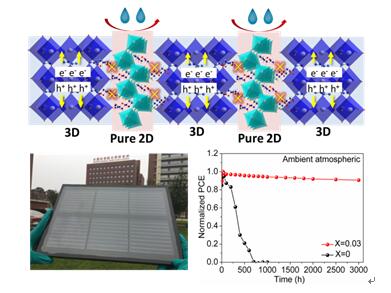As a direct band gap semiconductor material, metal halide perovskite has the advantages of structural designability, adjustable band gap, suitable band gap width, high carrier mobility and low cost. It is the third generation thin film solar cell Representative material. However, the sensitivity of the three-dimensional perovskite to water and oxygen has led to a sharp decline in the efficiency of the device under natural working conditions, which has seriously hindered the commercialization of perovskite solar cells. As an extension material of three-dimensional perovskite, two-dimensional perovskite has greatly improved stability due to its hydrophobicity and insensitivity to light. Due to the particularity of the two-dimensional material structure, electrons or holes are limited by the quantum size effect, and their lifetime and mobility are much lower than the three-dimensional structure, so their device photoelectric conversion efficiency is significantly lower than that of the three-dimensional perovskite. This contradiction between stability and high efficiency has become a difficult problem in practical applications.
With the support of the National Natural Science Foundation of China, the Ministry of Science and Technology and the Chinese Academy of Sciences, the research team of Song Yanlin, a researcher of the Key Laboratory of Green Printing of the Institute of Chemistry, Chinese Academy of Sciences, used green nano-printing technology to finely pattern the perovskite single crystal (Sci . Adv. 2018, 4, eaat2390), printed flexible solar cells (Adv. Mater. 2017, 29, 1703236) and perovskite wearable devices (Energy Environ. Sci. DOI: 10.1039 / c8ee01799a) conducted a series of studies .
Recently, the researchers of the laboratory have collaborated with the School of Physics of the University of Macau to successfully introduce the pure two-dimensional perovskite into the three-dimensional perovskite system, which overcomes the limitation of the quantum size effect of the carrier transport process. A highly oriented 2D-3D perovskite lateral suppression junction film was used, and a high-efficiency, high-stability modular perovskite solar cell was prepared using printing technology. As shown in the figure below, they chose a two-dimensional perovskite with long-chain diamine ligand (EDBEPbI4), which on the one hand inhibited the formation of a variety of two-dimensional phases and ensured the super-hydrophobicity of the two-dimensional perovskite. On the other hand, the amine molecules in the two-dimensional perovskite can coordinate with the organic cations in the three-dimensional perovskite, so that the pure phase two-dimensional perovskite can be embedded at the grain boundary of the three-dimensional perovskite to suppress the current carrying The non-radiative recombination at the grain boundary prevents water and oxygen from corroding the film from the grain boundary, resulting in a perovskite solar cell with a photoelectric conversion efficiency exceeding 21%. Modular components prepared by printing technology, under natural conditions, after 3000 hours of attenuation test, the photoelectric conversion efficiency remains at more than 90% of the initial value. After 500 hours of light test, the efficiency of modular components is less than 10%. Through this two-dimensional to three-dimensional perovskite structure design, modular ultra-high efficiency and ultra-stability perovskite solar cells are realized at the same time, which is of great significance to promote the practical application of perovskite solar cells. The research results were recently published in "Advanced Materials" (Adv. Mater. DOI: 10.1002 / adma.201805323).

Modular perovskite solar cell and stability
Optical Brighteners are important raw material in Detergent, Textile, Paper industries. DMS, CBS are mainly used for detergent field, such as: DMS is regarded as one of the perfect agent used in detergent industry, owing to introducing the morpholine group into the molecular, the properties such as acid and perborate resistance be improved. It can be used in the whitening of cellulose fiber, polymide fiber and fabrics, showing anionic characteres and has optical bule color, it has better resistance to chloride bleaching than VBL and 31#, the most favorable dyeing bath PH value is 7-10.
BA & BBU mainly are used for paper industry.
*Related Products:Optical Brightener ba,optical brightener bbu,optical brighener cbs-x,optical brightener cbw.
Optical Brightener
Optical Brightener,Optical Brightening Agent,Optical Brightener For Cotton,Optical Brightener Agent
SJZ Chenghui chemical co ltd , https://www.chenghuichemicals.com